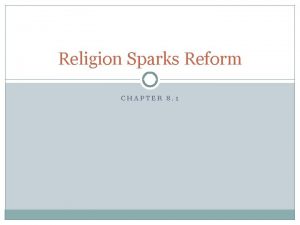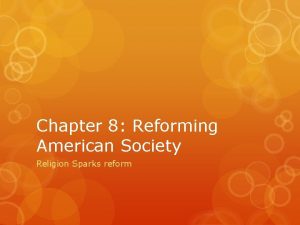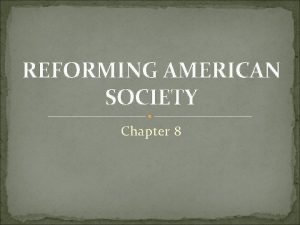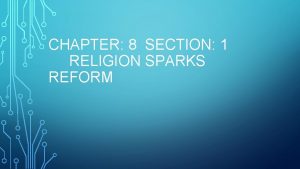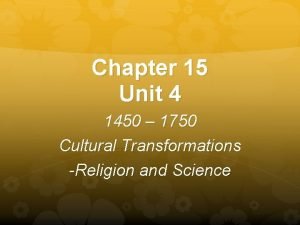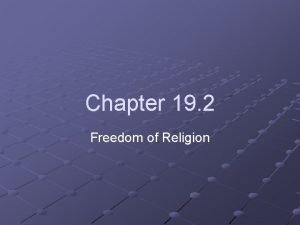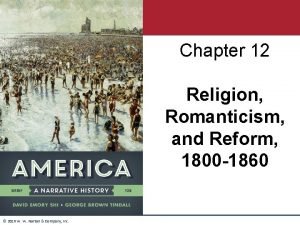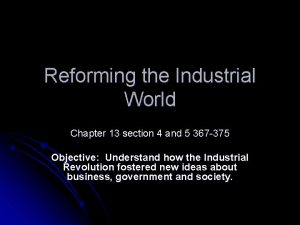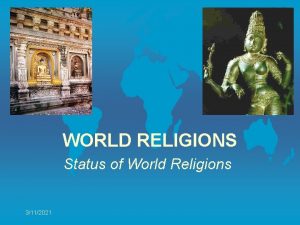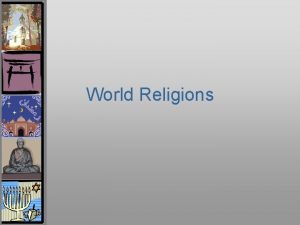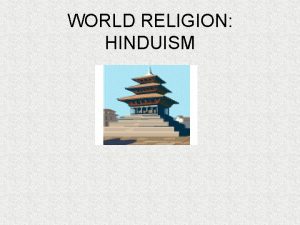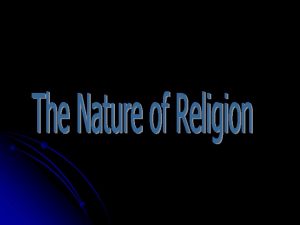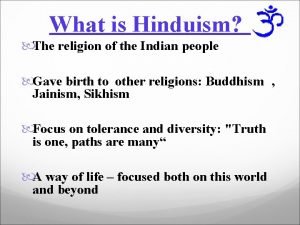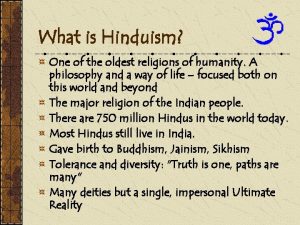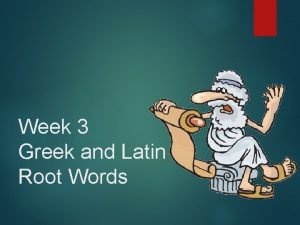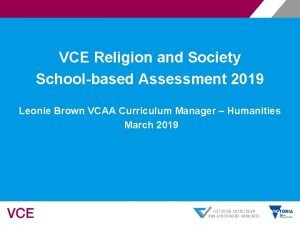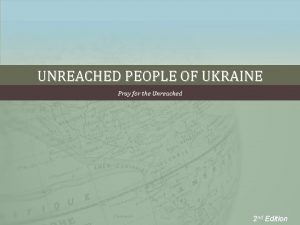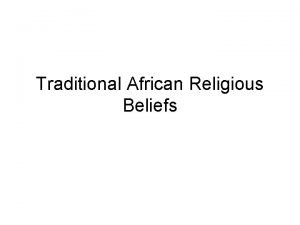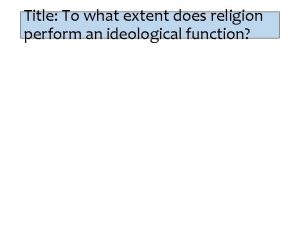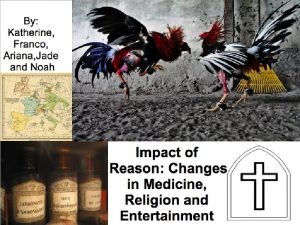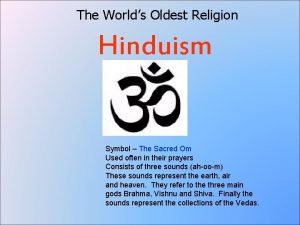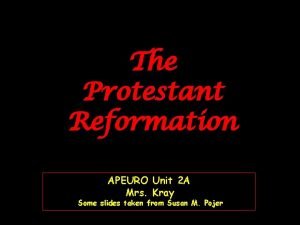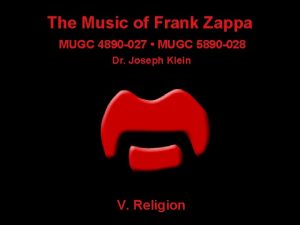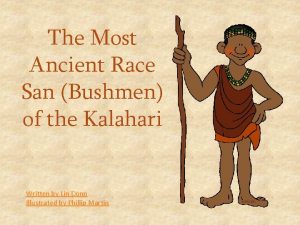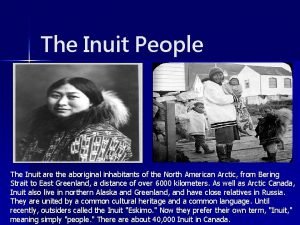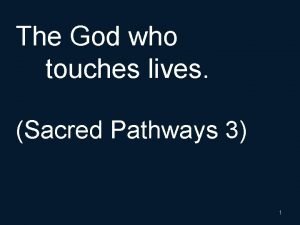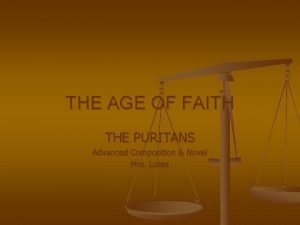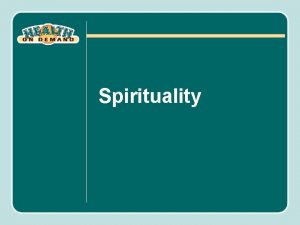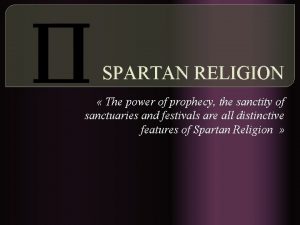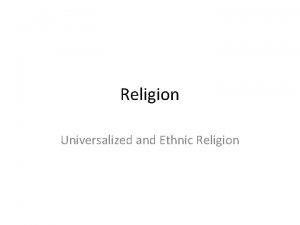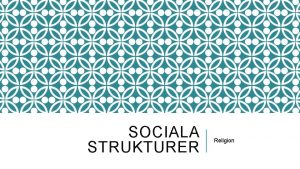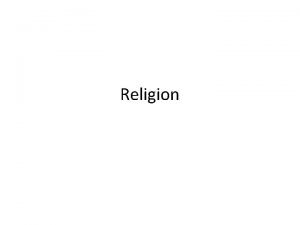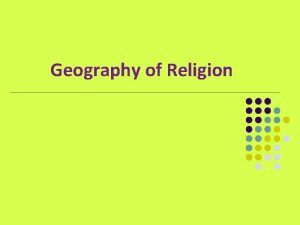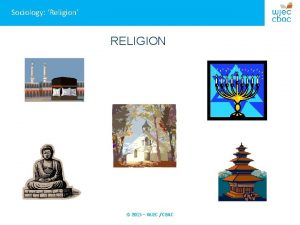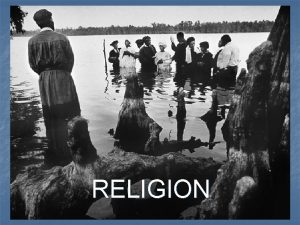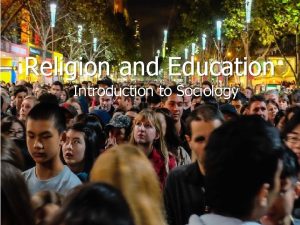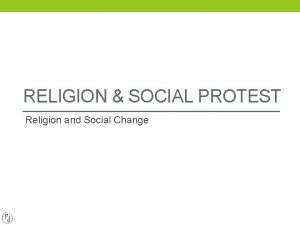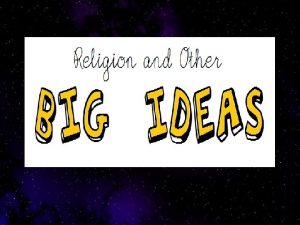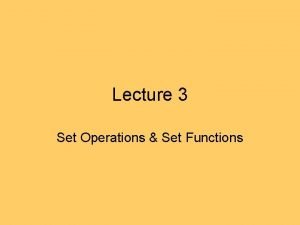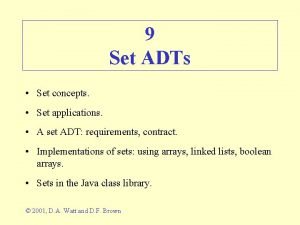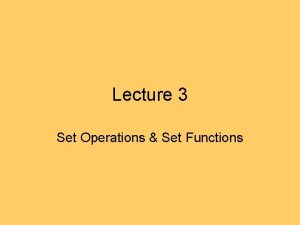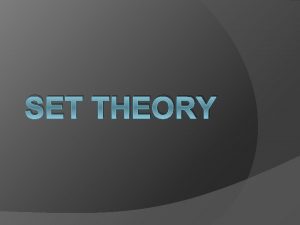Chapter 9 Religion What is Religion A set














































- Slides: 46

Chapter 9: Religion

What is Religion? A set of beliefs that include a notion of ‘god’, or some kind of supernatural force beyond our direct experience. A set of practices involving things such as collective worship or prayer. Monotheistic, Polytheistic, non-theistic (supernatural forces, mother nature) personal worship, communal worship, exorcisms Organization for beliefs to be collectively expressed. places (church/mosque), leaders (priests/imams)

Diversity & Effects of Religion The characteristics of religion are very diverse- expressed in many ways across three dimensions Historical – in same society over time Contemporaneous – in the same society at the same time Cross-cultural – between different societies Religion is hard to define because it has a dual character – individual and social Religion plays certain functions for society: Socialization into moral beliefs and values (don’t kill) Social Solidarity – belief that in a society its members have things such as values, norms, beliefs and practices in common. Social Control – direct (commandments, sharia) and indirect rules (what would Jesus do? ) to live your life by

Inclusive Approach to Religion Inclusive approach sees religion in the broadest possible terms Instead of defining religion, functionalists focus on what religion does for a person religion helps people by answering questions for them. - religion is seen in the broadest sense Religion brings social solidarity – people feel like they belong to a group Religion provides social integration – the ways social solidarity is created through shared practices and experiences (fasting, reconciliation) The focus on function means that the content of religious beliefs is unimportant Who, what For or how people worship doesn’t matter inclusive approaches, the key to understanding religion is to see it as a belief system (ideology), based on faith: the uncritical and unconditional acceptance of a particular set of ideas.

Inclusive Approach Continued…. Society’s definition of religion develop through people’s own behavior Totemism – religious belief that an object, plant or animal is both sacred and has some form of supernatural powers (Native Americans) Inclusive approach is criticized because with this perspective religion can be seen anywhere, from football games to churches Therefore, there is no way of knowing if societies are becoming less religious (secularization) or more religious (resacrilization) TEST YOURSELF pg 292 – Identify two features of an inclusive definition of religion

Exclusive Approach to Religion Exclusive approach considers religion in a narrower sense, in terms of things that are conventionally seen as religious Belief in a god or the supernatural Behavior such as prayer, collective worship, and ceremonies Exclusive approaches involve a substantive definition of religion focused on its content or substance: the beliefs, practices and organizations that are distinctively religious and that mark religious behavior as substantively different from other, similar, behaviors. According to exclusive approach, religion has essential characteristics: Sacred all societies make a distinction between the sacred, anything considered special or holy, and the profane, the everyday and ordinary. Moral codes (Ten Commandments) Communication with the supernatural, through mechanisms such as prayer Critics of this approach question whether religion really does have unique and exclusive features. Claim that the exclusive approaches simply adopt a definition that fits neatly with conventional, mainstream world religions such as Christianity and Islam. END PERIOD 1 (pg 292)

Functionalist Approach to Religion Functionalism takes an inclusive approach Cultural institutions (including education and media) create and maintain order and continuity by promoting a collective conscience. Focuses on how religiohn creates, promotes, and maintains the cultural values that provide the moral basis for social order. Collective Conscience – society’s ‘collective will’ that bears down on individuals, shaping their beliefs and behavioral choices. (Durkheim) Durkheim - Religion’s message is not as important as its effect of ‘bringing people together’ – similar to sports or clubs

Alpert’s 4 Major Functions of Religion 1. Discipline – a sense of shared beliefs and values is created by following a set of moral rules and codes. These common values create and connect people to society. 2. Cohesion – religious ceremonies bring people together in situations where they put into practice their shared norms, values and experiences , thereby reinforcing social solidarity. religious ceremonies bring people together. Symbols are used such as wedding rings that have shared meanings. wedding represents marriage + commitment to partner symbols help distinguish between the sacred and profane

Alpert’s 4 Functions of Religion 3. Vitalization – shared religious beliefs and experiences bind people together identity – people understand who they are through religion revitalization – common culture transmitted from generation to generation, developing continuity through tradition and custom. 4. Euphony (harmony) - in times of pain and crisis, religion brings harmony tension management - rituals for death help manage this traumatic situation - meaning religion offers explanations for events that nothing else can (it’s all part of God’s plan)

Rituals Ritual – constantly repeated aspects of religious belief and practice, usually involving some form of ceremony. What are some rituals that are a part of your religion?

Neo-functionalism Neo-functionalists notes that in USA/Europe people are not particularly ‘religious. They don’t participate in collective ceremonies and services. Reevaluation of the function of religion Religion is not a function of ‘whole societies’ but some individuals Neo-functionalism also talks about dysfunction - religion creates conflict (ie-violent Christian fundamentalists opposing abortion) Religion is not automatically and inevitably functional Religion can bring social change - Christian churches and civil rights in the 1960 s - Protestants and abolitionism in the 1800 s

Marxism and Religion Marxists – promoting a consensus that will ultimately benefit the ruling class Exclusive approach – focusing on features that make it different from other forms of belief and practice Religion shapes how people see the world and its role is to represent the world in ways that reflect and support the existing social order. Religion explains ‘everything about everything’ Religion makes the people in poverty accept their situation. Religion is a system of social control. Everyone should accept the world as it is Marx called religion the ‘opiate of the masses’. It dulls the pain of life with promises of eternal life and happiness (heaven, nirvana, etc. ) Liberation Theology – belief that the church should use its power and resources to liberate the poor from their poverty.

Neo-Marxism embraces the concept of hegemony (leadership through consensus) Lower classes accept the ideas of the ruling classes and their leadership because they are ‘ideologically indoctrinated’consensual They are powerless to challenge or change them Religion is less of a coercive force and more of a cohesive force for the ruling class to reproduce itself (through inheritance and marriage)

Weberian Approaches Weberian approaches focus less on what religion does and more on what religion means for: Individuals – studying the motivations, behaviors and beliefs of the religious Society – developing cultural identities, legal systems, economic systems Weber believes that religion can bring social change He wanted to understand why capitalism developed in some societies but not in others even though they had reached same technological developments Calvinist ideals pushed for it through its teachings successful, hard work, moral, thrifty, modest Protestant Ethic – serving god through hard work, thrift, moral uprightness. Weber says that this is the foundation of capitalism

Interactionism (neo-Weberian) Interactionists focus on how collective religious beliefs provide a framework for how people understand the world. prior to modern science, people usually resorted to religion to ‘explain the unexplainable’ Religion guides understanding by: explaining experiences, interprets meaning and significance, creates common cultural meanings. Through an inclusive approach, interactionist perspectives explore how religious ideologies provide an organizing structure to peoples’ lives. Content of religious beliefs does not matter -- religious ideas are believed because they plausibly explain something. When explanations are no longer plausible, they are discarded and new explanations are formed. (the world is flat, god live on Mt. Olympus) STOP PERIOD 1 STOP PERIOD 4

Religion and Social Change Traditional Functionalism – by worshiping God, people ‘are worshiping society’ (Durkheim) The collective conscience of ‘will of society’ controls individual behavior. people are naturally selfish which is bad for society, so religion encourages people to give up their selfishness religion is an important source of values and norms Religion maintains the collective conscience by: moral codes are given by God participation in collective ceremonies participation in religious rituals makes one feel a part of something bigger than themselves

Secularization In many modern, culturally diverse societies, traditional forms of religion no longer have a monopoly of faith Secularization involves religious institutions losing their power and control over secular (non-religious) affairs. It is argued that secular societies develop civil religions Civil Religions – ideas and practices that while not overtly religious in content, perform the same function as religious organizations in a society. this is a result of secularization other institutions provide the ‘collective conscience’ in the absence of religion

Traditional Marxism – religion provides the ideological justification for things like social inequality in capitalist societies. Religion is an inherently conservative force that exists to support the economic status quo in two main ways: Oppressively – imposing a set of “god given” values and beliefs Supportively – when a country undergoes economic crises that threaten their stability Religion channels social dissent and helps to preserve the status quo by promoting limited social change or managing social transformations.

Neo-Functionalism argues that religion can initiate social change. Millenarian Movements – religious movements characterized by their belief that God will intervene to create some sort of collective salvation, on Earth and/or in heaven for chosen believers. Change can be: Transformative – Jehovah’s Witnesses aim to change the world, Muslims create societies based on Sharia Law. Transitional – changing religious attitudes to homosexuality or having female priests. According to neo-Functionalists, societies are constantly adjusting to maintain equilibrium.

Neo-Marxism Look at religion in terms of cultural transitions. Cultural Transitions – neo-Marxist concept to express the idea of relatively small changes in the lives and positions of people and groups within a society. In capitalist societies economic crises threaten stability. Religion is a tool to bring about social change and in turn, bring stability Civil rights in 1950 s and 1960 s organized through Baptist church Roots were in political and economic deprivation of African Americans

Modernity, Post-Modernity, Fundamentalism Privatized forms of Worship – religion that is practiced in the private rather than the public sphere. Asceticism – practice of a strict self-discipline that uses abstinence and austerity (simple life) for spiritual belief. Religious Consumerism – claim that in postmodern society religions behave more like business organizations, where customers are encouraged to buy into a range of different beliefs, practices, and organizations. Spiritual Shopping – idea that postmodern religious consumers are more likely to ‘shop around’ for a faith or religion that suits their individual needs.

More Vocabulary!!!!!!! Fundamentalism – forms of belief and organization that advocate a strict observance of the ‘fundamental beliefs’ of a religion. (focus on the core or roots, traditional) Atheism – belief that there is no supreme being or deity. Agnosticism deity. – not being sure if there is a supreme being or

Modernity 3 types of developmental change in modern societies economic and industrial forms of production political and various forms of democracy cultural and new, powerful, belief systems centered around science Challenges to religion questioning secular rulers and their divine rule cultural developments, like scientific explanations of nature and evolution ***Modernity brings about a loss, disappearance, decline, retreat, reinvention

Modernity (continued) Loss of religious influence over the individual and/or society Disappearance Pre-modern societies, tradition, custom, and religion were the main ways of explaining the world and the individual’s position in society Lacked scientific knowledge to understand natural phenomena As it developed, the need for religious explanations declined Religion became a necessary stage in human development – eventually will disappear as science provided hard facts Decline Wilson argues that religion is increasingly marginalized as a social force While religion doesn’t disappear entirely, it retreats from the public to the private sphere and this results in a decline in the power of religion and its influence over people’s perceptions of the world Ideological attacks from scientific rationalism Promise to create more rational, understandable and equal set of social relationships without leaving people feeling confused or betrayed Cults, sects, new religious movements.

Modernity (continued) Retreat & Reinvention: Religion is a retreat from secular society and a reinvention through a process of structural differentiation Modernity produces two processes: Decline Fewer people engaging in religious practices Atheists Loss and agnostic of secular politic Adaptation Adapt & reinterpretation to changed position in society Reinterpret role and function in society

Post - Modernity No single definition of religion Focus on following arguments: God is dead; religion disappearing Return to traditional faith (resacrilization) Religion is evolving and taking new forms Metanarratives Stories that explain everything about something or everything about everything Religion – represent a general framework around which individuals beliefs, practices and experiences are orientated and ordered. Exclusive truth – narratives are not simply true, they are the only form of truth Contradictions: Religion is becoming less important in terms of practice Source of personal and social identity PRIVATIZED FORMS OF WORSHIP – religion that is practiced in the private rather than public sphere. STOP

Different Religious Movements (p 309 -314) Church-Type Organizations Social Capital Ideology Denomination Pluralism Sect Typologies

Church-Type Organizations Church – a type of religious organization characterized by its size, power and influence over religious and secular matters. (Christianity, Islam, Hinduism, Buddhism) Historically - churches would control knowledge (middle ages) - economically powerful (own land) - politically powerful (align interests with people or groups) - cross-culturally (Iran – Ayatollah is political, economic, religious leader) Powerful, Control Lives, Large Bureaucracies, Inclusive (easy to join) Don’t proselytize (actively try to convert people)

Social Capital Two types of social capital that churches use 1. Inclusiveness and Cooperation (unlike cults and sects) - outward looking - viewing matters outside religion - heterogeneous –tolerate a range of different beliefs and religious groups - reciprocal – willing to cooperate with and learn from other organizations - ecumenical – pursue varying levels of cross-church cooperation (representing several Christian churches) Bonding Capital is more exclusive - bonds members together but is set apart from other organizations - ie – cult members have strong bonds, that set them apart from society

Ideology – since churches are large-scale cultural institutions, they contribute to society’s collective conscience. - churches align themselves with the ruling powers by offering political, economic and ideological support. - churches are more integrated with the secular world than sects and cults

Denomination – organized sub-divisions of a major religion - Roman Catholic and Protestantism are denominations of Christianity - Sunni and Shia are denominations of Islam Denominations develop from schisms (splits) - develop from ideological differences, political differences, geographic isolation - denominations are inclusive like churches

Pluralism Religious Pluralism – idea that in modern societies have a wide range of religious beliefs and organizations to choose, and no religious organization can claim a monopoly of belief and practice. - supports diversity - tolerance for atheists Sectarian Cycles – cycles of religious conflict that lead a discriminated group to split from the main religion to form their own denomination or sect.

***Sects Sect – type of religious organization characterized by a membership held together by collective feelings of deprivation. - charismatic leaders frequently offer innovative solutions to the religious and secular problems experienced by individual members Sects develop around 2 forms of dissent: 1. Religious (disenchantment) – being let down by a religion, a weakening of faith 2. Social – individual deprivation - ie – economic (monetary benefits), ethical (not compatible), psychic (searching for meaning or direction)

Sects ** Its argued that deprivation is necessary for a sect to develop - entry into a sect requires a test - there is no paid clergy - people are seeking something (ie- Scientology) Also, involve promises/benefits - feeling of superiority through access to ‘hidden knowledge’ - feeling of belonging to a strong, supportive community Some groups share benefits with society - Jehovah’s Witnesses give everyone the opportunity to be saved from damnation (sometimes aggressively)

Cult – loose-knit, individualistic, type of religious/spiritual organization that collects around a set of common themes, beliefs, or interests. - highly individualistic - diversity is a characteristic, 1000 s of cults around the world - Survivalist cults, using magic to find the perfect partner, etc. Cult Characteristics: - authoritarian, centralized power, communal (isolation), totalizing (all aspects of members life can be regulated) Typically attract people who are seeking short-term solutions to complex problems Recruiting, indoctrinating, and influencing members is a similar socialization process to any group or organization

(p 315 -322) New Religious Movements – an alternative way of classifying sects and cults that attempts to remove the stigma from these terms. NRM describe movements that developed in the mid-20 th century and resolve the confusion between sects and cults. - Answer fundamental questions about life and death - Rites of passage that mark ‘key events’ - life-coping strategies addressing problems of existence, ie – how to be successful in business - ethical codes to live by Rationalization – ideas used by powerful groups to justify and explain their domination in society.

Types of NRM’s World Rejecting – type of sect whose members reject the secular world by collectively withdrawing from contact with that world. World Accommodating – type of sect that neither rejects nor promotes the secular world; the two simply co-exist. World Affirming – type of sect that offers to unlock the individuals ‘hidden potential’ in ways that will make them more successful in the secular world.

Secularization – making changes to something so that it is not influenced by religion Religiosity – being religious, especially in terms of levels of belief, behavior and commitment. – used in comparison of times - further back we go the more religious typically societies were Religious Beliefs – belief in a deity or supernatural power that may have some control over people’s destinies. - orthodox – believing in a single all-powerful deity - unorthodox – believing in witchcraft, or a vague ‘spirituality’

Belief (knowing) Believe without belonging: - people can hold religious beliefs while showing little or no commitment to religious organizations or practices. - they can believe in God without aligning that belief to any organization. Belong without believing: - this involves those who attend religious services without having any strongly developed sense of religious belief. - religious practice may have secular functions such as: friendship, social status, custom, tradition

Participation and Commitment These are ways in which we try to measure religiosity and secularization: Participation (doing) - the extent to which people participate can be hard to define/count Commitment - the extent to which people belong

Pro-Secularization arguments are based on the claim that religion has declined in significance in the developed world. - ideas and organizations that once held much control over peoples lives have weakened - scientific knowledge challenges religious ideas and weaken their power Disengagement – process by which people withdraw from religious involvement, in terms of beliefs and practices. Religious Diversity – existence of different forms of religious belief, practice and organization in a society Religious Revival – a contemporary growth in the popularity of different religions. - NRMs have shown some signs of growth, compensating for decline in traditional religious beliefs.

Anti-Secularization Anti-secularization theorists say that it is impossible to distinguish between religious and secular in a way that can be studies academically. - see secularization as an intellectual tool to attack religion Religion in modern societies is still strong - it provides moral codes Religion has evolved or changed over time because new institutions have taken over the functions (loss of functions) - ie – festivals for leisure or fun

Religion and Social Class (p 323 -330) Social Class - middle and upper classes tend to be regular attendees of church - working class people tend to only attend church for weddings and funerals Historically attending church was a source of social status Self-identity through religion has declined in modern societies - much of this is due to religious pluralism, especially with NRMs (new religious movements). Middle class makes up most of the people joining NRMs

Gender and Religion In western societies, women are more religious than men by nearly every measure. UK Stats - 83% of women claim affiliation to a religious organization - 74% of men claim affiliation to a religious organization, church or denomination. USA Stats - 86% of women claim affiliation to a religious organization - 79% of men claim affiliation to a religious organization 36% more British women then men believe in the certainty of a God’s existence. 15% difference between women and men in USA.

Women in Religion More women believe in life after death More women attend church events, clubs, activities, etc. Women are more likely to attend church Women are more likely to pray independently *** Despite this, men typically dominate positions of authority in religious organizations. Feminists explain this is due to differing of gender roles. Patriarchy – male-dominated society Religion makes sense of this male-dominated world and justifies it, according to feminists

 Total set awareness set consideration set
Total set awareness set consideration set Training set validation set test set
Training set validation set test set Western religion vs eastern religion
Western religion vs eastern religion Bounded set vs centered set
Bounded set vs centered set Fuzzy theory
Fuzzy theory Crisp set vs fuzzy set
Crisp set vs fuzzy set Crisp set vs fuzzy set
Crisp set vs fuzzy set What is the overlap of data set 1 and data set 2?
What is the overlap of data set 1 and data set 2? Correspondence function examples
Correspondence function examples Religion sparks reform chapter 8
Religion sparks reform chapter 8 Chapter 8 section 1 religion sparks reform answer key
Chapter 8 section 1 religion sparks reform answer key Chapter 8 section 1 religion sparks reform
Chapter 8 section 1 religion sparks reform Chapter 8 section 1 religion sparks reform
Chapter 8 section 1 religion sparks reform Chapter 15 cultural transformations
Chapter 15 cultural transformations Chapter 19 section 2 freedom of religion
Chapter 19 section 2 freedom of religion W.w. norton
W.w. norton Reforming the industrial world chapter 9 section 4
Reforming the industrial world chapter 9 section 4 World religion map 2021
World religion map 2021 Judaism universalizing or ethnic
Judaism universalizing or ethnic Brahman
Brahman Politics communion 000yearold holy mystery
Politics communion 000yearold holy mystery What is reincarnation in hinduism
What is reincarnation in hinduism The oldest religion
The oldest religion Dyna root word
Dyna root word Which religion did mansa musa follow?
Which religion did mansa musa follow? Religion and society vce
Religion and society vce Ukraine main religion
Ukraine main religion Whats ukraines religion
Whats ukraines religion West african animism
West african animism Religion and conflict theory
Religion and conflict theory Imptimatur
Imptimatur Difference between catholic and christian
Difference between catholic and christian Oldest religion in the world
Oldest religion in the world Cult vs religion chart
Cult vs religion chart Puritans religion beliefs
Puritans religion beliefs Catholic vs christian
Catholic vs christian What god does hinduism believe in
What god does hinduism believe in New england colonies religion
New england colonies religion Frank zappa religion
Frank zappa religion San religion
San religion Inuit religion
Inuit religion This is the religion that god accepts
This is the religion that god accepts The smell of
The smell of The hohokam and anasazi achievements
The hohokam and anasazi achievements Puritan beliefs
Puritan beliefs What is the difference between spirituality and religion
What is the difference between spirituality and religion Sparta religion
Sparta religion









